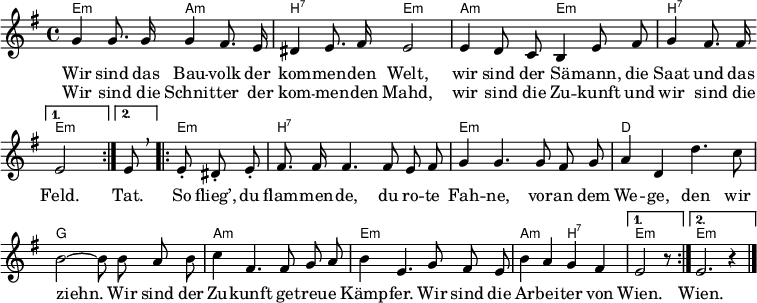"Die Arbeiter von Wien" is a song, which probably was written in 1927 when 89 protesters were killed during the July Revolt by police forces which were firing into the outraged crowd. The text of this Arbeiterlied was written by the Viennese poet and essayist Fritz Brügel (1897–1955). The song's melody is derived from the Soviet march " White Army, Black Baron" by Samuel Pokrass.
History
The song was performed for the first time in 1929 at the 2nd International Workers' Youth Day in Vienna. The song became more widespread in 1934 during and after the Civil War between the Austrian labor movement and Social Democratic Party and the Fascist authoritarian dictatorship and its organizations. In Vienna, Styria and Upper Austria in particular, workers spontaneously rose up against Austrofascism without any central leadership. Their struggle was bloodily suppressed, but the "Die Arbeiter von Wien" song became part of the international anti-fascist song repertoire.
Lyrics
Wir sind das Bauvolk der kommenden Welt,
Wir sind der Sämann, die Saat und das Feld.
Wir sind die Schnitter der kommenden Mahd,
Wir sind die Zukunft und wir sind die Tat.
Refrain
So flieg’, du flammende, du rote Fahne,
Voran dem Wege, den wir ziehn.
Wir sind der Zukunft getreue Kämpfer.
Wir sind die Arbeiter von Wien.
Herrn der Fabriken, ihr Herren der Welt,
Endlich wird eure Herrschaft gefällt.
Wir, die Armee, die die Zukunft erschafft,
Sprengen der Fesseln engende Haft.
Refrain
Wie auch die Lüge uns schmähend umkreist,
Alles besiegend erhebt sich der Geist.
Kerker und Eisen zerbricht seine Macht,
Wenn wir uns ordnen zur letzten Schlacht.
[1]
Refrain
Melody

Notes
- ^ "Die Arbeiter von Wien". dasrotewien.at. Retrieved 2024-03-14.
References
- Karl Adamek: LiederBilderLeseBuch. Elefanten Press, Berlin 1981. ISBN 3-88520-049-X